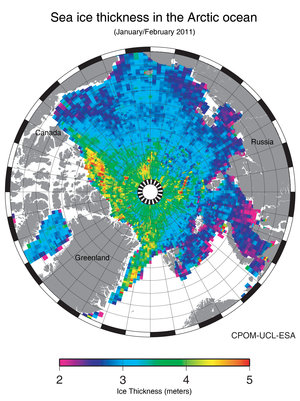CryoSat rocking and rolling
ESA’s ice satellite is rolling left and right in orbit to help it continue its precise measurements of the vast ice sheets that blanket Greenland and Antarctica.
Since its launch 18 months ago, CryoSat-2 has been collecting data to improve our understanding of the relationship between ice and climate.
Just this year, the first map of Arctic sea-ice thickness was unveiled, and the satellite will continue to monitor the changing ice for years to come.
To ensure the precision of the measurements, an operation is under way to roll the satellite from side to side as it flies over the flat oceans.
This manoeuvre is to calibrate CryoSat’s radar altimeter for measuring ice thickness, especially over the margins of ice sheets.
The altimeter has two antennas mounted on a bench about a metre apart. When it is working in the ‘SARIn’ mode, both antennas are used in parallel: one emits a signal and both receive the signals that bounce back.

Normally, this bench is parallel to Earth’s surface. But at the edges of the ice sheets, the ice surface is not always flat and the slopes affect the return signals.
Harsh conditions in space – with huge temperature differences between Sun and shade – can lead to the deterioration of CryoSat’s instruments, which can also lead to measurement errors.
In order to quantify these errors, ESA ground controllers are working to recalibrate the altimeter.
They are rolling the satellite to simulate the ice slopes and holding it in this position for several minutes. This must be done while CryoSat is over large, flat surfaces. For satellite altimeters, oceans are Earth’s largest flat surfaces.
It will also check whether errors are related to CryoSat’s varying thermal conditions – like when exposed to the Sun or in the shade.
“With the results from the different sets of rolls over different ocean surfaces and at different ambient conditions, we are aiming to characterise the instrument to a precision better than we thought we could make at the time of the launch,” said Tommaso Parrinello, CryoSat mission manager.

During several manoeuvres on Monday and Tuesday, the satellite is rolling 0.4º to both sides while over the Indian and Pacific oceans, before returning to its original position.
“The preparations for the roll activities have been quite challenging,” explained Nic Mardle, spacecraft operations manager.
“Although we had experience of these activities from the commissioning phase, we had to iterate a few more times with the planning and mission control teams so that we could support exactly what was required.”
The complex calibration is a joint effort between ESA’s ESRIN centre for Earth observation in Italy and its ESOC operations centre in Germany.
CryoSat is dedicated to monitoring changes in the thickness of marine ice floating in the polar oceans and of the vast ice sheets that extend over Greenland and the Antarctic.
Satellites have already shown that the extent of sea ice in the Arctic is diminishing. In fact, this year’s minimum has set a new record low.















 Germany
Germany
 Austria
Austria
 Belgium
Belgium
 Denmark
Denmark
 Spain
Spain
 Estonia
Estonia
 Finland
Finland
 France
France
 Greece
Greece
 Hungary
Hungary
 Ireland
Ireland
 Italy
Italy
 Luxembourg
Luxembourg
 Norway
Norway
 The Netherlands
The Netherlands
 Poland
Poland
 Portugal
Portugal
 Czechia
Czechia
 Romania
Romania
 United Kingdom
United Kingdom
 Slovenia
Slovenia
 Sweden
Sweden
 Switzerland
Switzerland































